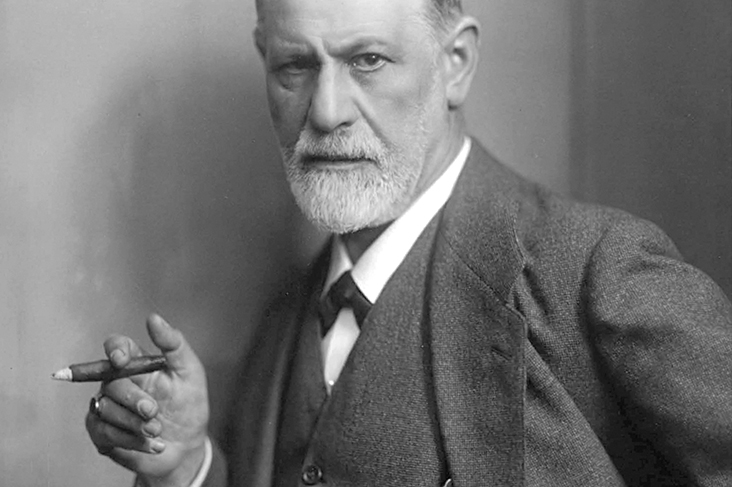Sigmund Freud, born in May 1856 in Freiberg, present-day Czech Republic, was an Austrian neurologist and the founding father of Psychoanalysis. Psychoanalysis is the term used for a clinical method used to evaluate and treat aberrations and pathologies in the Psyche. This treatment is conducted through a conversation. It is a meaningful dialogue between the patient and the Psychoanalytic.

Sigmund Freud’s Dream Theory
Sigmund Freud’s interpretation of a dream was that it was a representation of a disguised fulfilment of a repressed wish. According to him, the study of dreams and the patterns of their occurrence would prove to be one of the most vital and easiest routes to understanding the unconscious activities of the mind. These puzzle scientists even in this day and age.
Dreams consist of two parts – The first part is the manifested content or the tangible content. It is the part of the dream which can be remembered and visualized once the person is awake. This is the part of the dream that a person can actively break down and express and try to find meaning from.
The second part is the latent content. In this case, we do not remember the part of the dream, or it is part of the unconscious mind.
He then explained the second part, which is the latent unconscious part of the dream. He stated it consisted of 3 parts –
- The sensory part during the night of the dream
- The residue left from the day before
- The id drives which are already a part of the dreamer
Materials of a Dream

According to Sigmond Freud, the source of information and materials for any particular dream –
- Stimuli from the external world
- Organic stimuli from within the body
- Mental activities during the dream
Sigmund Freud realized that the dream contents are derived from life but not exactly similar to it. So he proposed that there has to be some connection that exists between these materials for them to translate into a dream.
He argued that these connections are not random but are a result of one’s unconscious desires. These translate into the materials which constitute the particular dream.
He stated that disagreeable dreams were more common than pleasant dreams. This constituted the hypothesis he came up with; that dreams disguise their true purpose. And require interpretation that will give one direction on how to understand them.
The latent dream is what was the real dream, according to his hypotheses. And deciphering it was key to understanding the process of dreaming and interpreting its occurrence.
He further elaborated on what a latent dream would consist of:
- Condensation – the process which is considered to be the simplification of the important and critical contents of the latent dream.
- Displacement – indicates a mismatch between the actual dream and dream-thoughts. The important things in the latent content are often represented by seemingly insignificant things in the manifest content and vice-versa.
- Symbols – The importance of figures, sigils, and markers in a dream which might constitute a clue as to what the dream is about and why the dreamer has it.
- Secondary revision – An aspect that makes disorderly dream materials fall into place into a more coherent form. This makes it easier for interpretation and may even result in the dream becoming more meaningful.
Sigmund Freud existed during a specific age and time when science considered dreams to be nothing but meaningless nonsense and states of delirium.
The theory that Dreams are nothing but random firing of neuronal synapses and just a normal brain activity for the body during REM sleep is still a popular theory amongst scientists even today.
There is also the fact that we, as conscious beings, invoke the above-mentioned theory and try to brush it under the carpet, saying that whatever we experienced or saw is not real. And we tend to use the phrase “It was just a dream” or “It was nothing but a silly dream.”
According to Sigmund Freud, a dream had some kind of meaning, no matter how nonsensical it seemed or how sporadic the memory was about remembering the dream. He was of the opinion that the human brain, considering the way it was designed and considering the number of functions it could perform and manifest, a process like that of dreaming would not be just randomly present.
Anything to do with the brain had to have a reason. And that it was quite capable of having an impact on the life of the individual. Dreams, although termed nonsensical by many, still hold specific meanings and scenarios which will require the psychoanalytic to uncover and understand them.
Dream Dictionary

One of the most popular approaches to interpreting dreams is with regard to and access to symbolism. There are fixed symbols that are interpreted in the same way by every individual who is dreaming. For example, if one person sees a monkey in their dreams, there are around 5-6 interpretations that are already pre-drawn by experts, and people have to choose the interpretation that they think it might denote.
This theory is considered central to Freud’s Interpretation of dreams, but it is not so.
All dreams are meant to have symbolic interpretations, but they are supposedly different for every individual. Therefore, the interpretation has to come from the individual and not the people who analyze the dream.
Sigmund Freud’s Methods of Dream Interpretation

Sigmund Freud’s methods of understanding and analyzing a dream were quite straightforward.
He avoided telling his thoughts to his patients and the people who he interviewed or checked via Psychometric analysis and discussions. Freud never revealed what he thought about the meaning of the symbols in their dream or even the meaning of the dream itself. Instead, he would encourage them to openly discuss their dreams and let them come to their own interpretations of them.
Also, he never gave them a certain thumb rule or set of directions. Instead, he would invite them to speak their minds. He would, in fact, request them to go along with it and try to understand their direction in the dream. This discussion was called Free Association.
This method of Free Association led Sigmund Freud to conclude that dreams are nothing but disguised fulfillments of infantile wishes. These wishes may have never been fulfilled in real life. The mind wanted acceptance for these aspects.
Eventually, this resulted in forming a subconscious pattern in the brain, which would project it as a dream. This also gave some respite to the dreamer as far as the fulfillment of their repressed wishes was concerned.
According to Sigmund Freud: “I must affirm that dreams really have a meaning and that a scientific procedure for interpreting them is possible.”
Regarding the satisfaction of wishes, Sigmund Freud says that a wish is a direct result that fills the gap between a want and a restriction. It is a general human tendency to pine for what we do not have or cannot have for some reason.
They could be restrictions put on you by others, or it could even be some self-imposed prohibition.
For example, when you are on your weight loss journey, you crave junk food, sweets, and anything unhealthy that disturbs your fitness regime. Everyone would happily agree that intense food cravings are hard to control. And sometimes you wish you could eat whatever your heart desires without gaining weight.
It is actually a utopian concept and goes against science. But unfortunately, your metabolism is not great enough, and you cannot really eat whatever you set your heart on.
So, you or your fitness trainer impose discipline with a strict diet and hitting an ideal calorie deficit for losing weight. This prohibition or restriction here can thus be the primary cause of your constant yearning for fast food. It is unhealthy but delicious. Therefore, if we cut back on junk food, we dream of it as our desires get suppressed.
This can be corroborated by Sigmund Freud’s daughter, Anna’s dream. She dreamt about the food she desired to eat as she was not allowed to eat for a while before that when she was sick. So she went to bed hungry and ended up dreaming about food.
Anna’s wishful thinking transformed into a dream. So, wishful thoughts combined with the urge to commit something that is forbidden or off limits find a way to emerge from your subconscious to be seen in your dreams.
Dream Distortion

The claim that dreams are just an embodiment of unfulfilled wishes is easy to criticize.
What about nightmares?
What about unpleasant dreams?
What about dreams which make no sense?
What about dreams where there is no structure and everything seems to be going wrong?
The above-mentioned questions are valid and seem to contradict Sigmund Freud’s theory that dreams are nothing but the fulfillment of the wishfulness of the dreamer. All the mentioned points suggest that dreams are anything but that. And one may go as far as calling them unpleasant and nonsensical experiences.
Sigmond Freud answered these questions with a statement saying that Dreams are not something that should be taken or interpreted directly at face value. Instead, they have a complicated underlying structure. It makes sense to first explore and map this structure.
The next step is its interpretation by the dreamer themselves and the Psychoanalyst who is having the interaction with the dreamer.
According to him, it is at the level of the thoughts behind the dreams that the dreamer finds the factors which result in wish fulfillment.
It was stated by him and mentioned earlier that there are two parts to a dream, the Manifest part and the latent part of the dream.
The wish-fulfillment aspect is found in the latent part of the dream, and this has to be interpreted and brought out by the process of Free Association. When one performs this exercise, they are able to tap into the latent aspect of the dream. This way, they try and find figurative points to understand the meaning of the content of the latent part of their dream.
Therefore, using this technique, they are finally able to manifest the entire reason they had the dream in the first place.
The wish Fulfillment aspect is also present in the Manifest form/pattern of the dream. But it is present in a hidden, disguised manner and has to be interpreted. The dreams which are taken at face value and not interpreted have no basis, according to Sigmund Freud.
In Freud’s own words:
“My theory is not based on a consideration of the manifest content of dreams, but refers to the thoughts which are shown by the work of interpretation to lie behind dreams.”
Dream Censorship
Freud argued that if the latent wish is disguised. There is something in the subconscious mind which is repelling or defending against that particular wish. That is the reason the wish is unable to find its way into the manifest part of the dream.
Freud had mentioned that prohibitions are part of the structure of a dream. But the prohibition need not always be from an external source. It can be an internal mental block – something that is keeping the mind from bringing the wish or thought to the forefront. How?? By subconsciously suppressing it at all times!
This prohibition was called Censorship by Freud, a factor that works to censor one’s dreams. These are repressed desires that an individual might possess. But, the mind is censoring and suppressing them in a way that cannot even manifest itself in the form of a dream and is always present in a disguised form.
Free Association is to bring out this disguised form to the front and interpret it clearly This helps to uncover the actual representation or meaning of the dream.
This explains to us that the mind has two forces constantly working:
- One force that is constructing the dream wish
- One force that is censoring the dream wish
It is a state of affairs where the mind is at war with itself at all times and is constantly contradicting its own thought process.
Freud concluded that for a wish to appear in a dream, it had to bypass the Censorship of the mind itself before it could manifest itself in the dream. And the only way the dream wish can do that is via distortion.
It means that the dream must appear in a format that the subconscious mind is unable to detect. And the detection part must be done via Free Association to interpret the suppressed wish.
According to Sigmund Freud, a dream is a process that is produced as a result of a compromise between these two opposing processes of the mind.
Verdict
In conclusion, Sigmund Freud was of the opinion that no matter what the dream is about, there is always a hidden meaning behind it. Because he was sure that the complex human brain would not be wasting precious resources in projecting something that would not add value to the resources used for the projection.
A dream should be scrutinized correctly by the process of Free Association since the projection was a matter of substance that could add value in any form to an individual’s life. And the upfront interpretation of the dream was crucial for understanding the subconscious dream wish of the dreamer.
Hope you liked the article. What are your thoughts on Sigmund Freud’s dream theory and interpretation? We would love to hear from you. Let us know what you think in the comments below.
